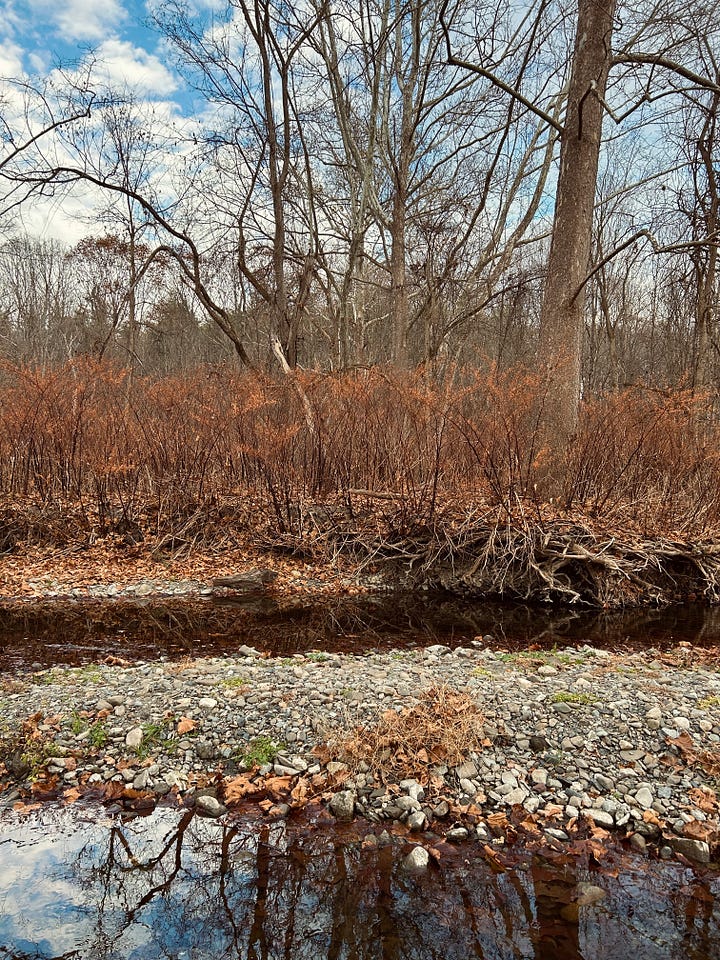November 6, 2024
The parking lot is empty when I pull into Siegel Kline, a nature preserve ten minutes down the road from my house. I stopped at the fancy French bakery on the way to buy a chocolate croissant, which sits packed in a brown paper box on the passenger seat. I’m holding out for it. I’ll walk the trail hungry, with the promise of something sweet on the other side.
This morning, I woke early and watched my son play with a truck on the kitchen floor. His latest obsession is garbage—literal garbage—so we bought him this cheap plastic garbage truck that makes beeping sounds and has a forklift for the bins. He beeps the horn and lifts his imaginary trash while I stand there weeping, thinking what a slag heap this country has become. What a waste.
Now I leave the pastry on the passenger seat and walk out into empty meadow. I haven’t been to this particular trail in a long time. When I get down past the clot of cottonwoods, I see that the waterway—the Siegel Kline Kill—has been completely diverted in my absence. The creek is cut in two. Where once there was a single spine, undulating across the rock bed, there are now two separate bodies of water. A weedy spit of land has cropped up between them. Small black spiders make the sand crawl. I test a log, imagining I’ll tightrope-walk it to the other side to explore, but I don’t trust my balance. So I accept defeat. I cannot, will not find my way across today.
My friend Nellie likes to come here to perform rituals by the water. She brings candles, recites prayers. Together, we once led a group of school kids in making Andy Goldsworthy-style land art, stacking rocks into spirals at the edge of the Siegel Kline Kill. But I don’t feel like making art right now. I had already decided—in the wake of releasing my latest album into the world, which tends to stir up the silt of self-doubt and not-enough-ness—to shut that part of myself down for a while. To let a piece of me die as the year dies, as the flowers die, as the bear retreats to its den for the death of long sleep. Death can be beautiful, I told myself. Look at the bioluminescence of phytoplankton—how their astonishing light is a death cry, turning the warming ocean into a starry night.
But then I hear Mount Eerie singing, Death is real… it’s not for making art about. And I feel my mind clamp shut like a trap.
“Kill,” it’s called, the Dutch name for river.
“Kill,” says the water at my feet, one body severed into two.
“Kill,” says the new-old president, making a target of our bodies, our rights, our land. On the far side of the creek, a wide bank of knotweed has gone red as fire.
Farther along the trail, I hear the sound of a thousand leaves shaking, though the trees are bare, the air is still. As I get closer, I see that there are hundreds and hundreds of grackles—a kind of blackbird—dancing in the branches above me. They fill the sky, a roiling black ball. It’s called a plague, I learn—the term for a group of grackles. Like a murder of crows or a parliament of owls or a museum of waxwings. I watch the plague move across the tree-line, overtaking the meadow, casting a shifting fist of shadow on this land I love.
Just before I leave the woods, I come upon another stand of knotweed. An invasive plant, Japanese knotweed is known for choking out native growth—though it can also be used as medicine, particularly to treat the inflammation that comes with Lyme, which is so common in these parts. When I saw it earlier from afar, across the divided Kill, it had looked like fire. This battering ram of a plant, like a torch-bearing battalion on the horizon.
But up close, I see that each lick of flame is a string of seed pods, and each pod is a see-through heart, and each heart holds a dot at its center—black as a plague—and each plague is a seed in which another life is possible.






Beautiful, Nandi. I walk with you. 💕